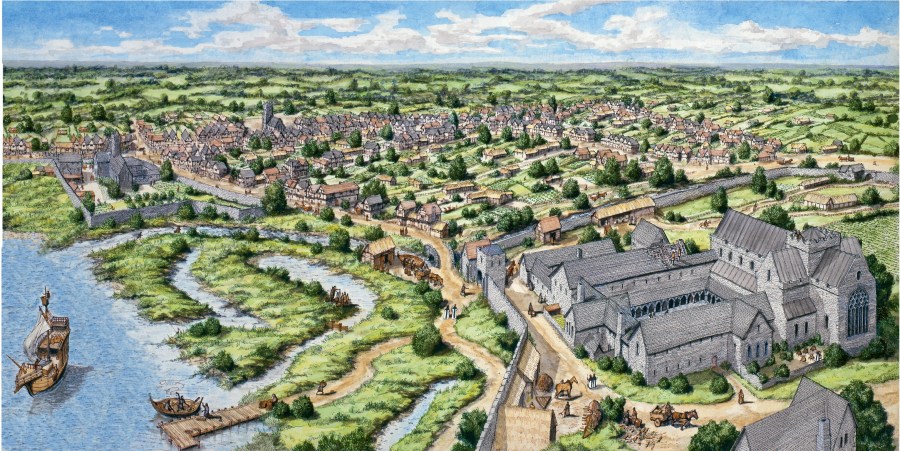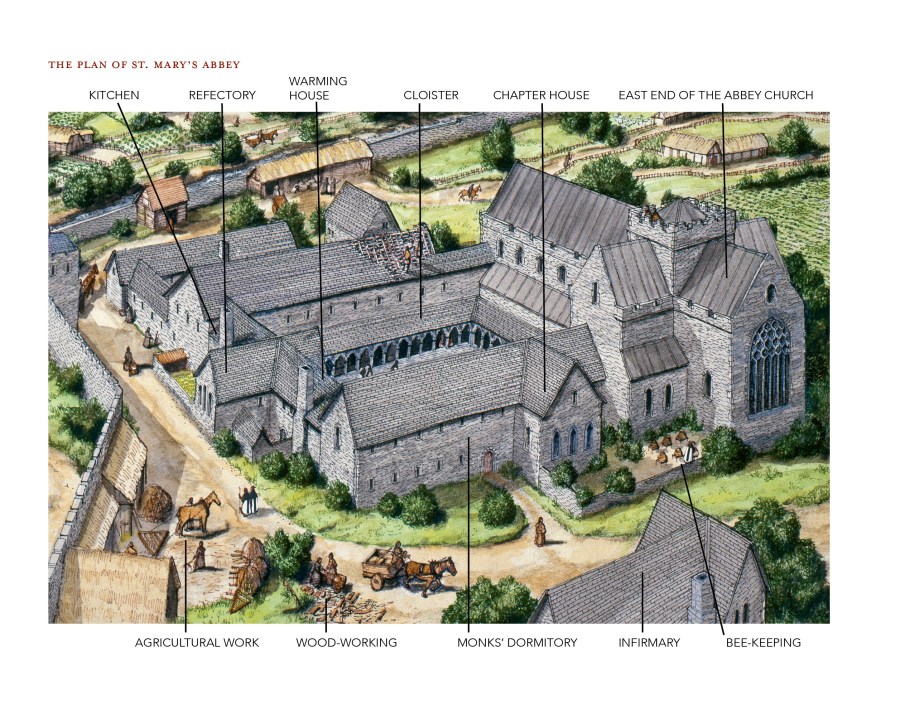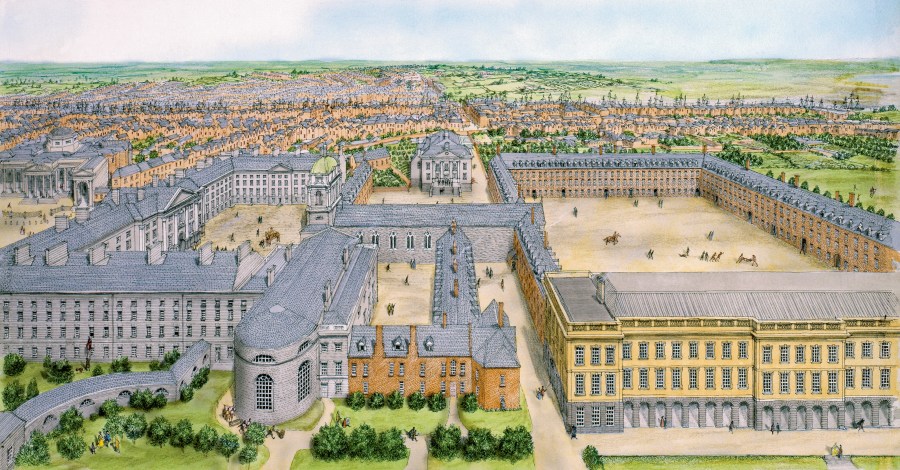Dublin: The Story of a City
The publication of any book of drawings by Stephen Conlin is something of an event for any student of our capital city. This book is particularly welcome, bringing together as it does most of the artist’s most important Dublin drawings, made in a long career stretching well over 30 years.
Even if you are not familiar with Mr. Conlin’s name, anybody who visits our key Dublin historic sites will have come across his artworks, and will undoubtedly have benefited from the experience. They are models of educational illumination.
One good example is the evocative image of Dublin Castle set in a snowy, medieval landscape. This image is on a large board that adorns the wall of the Under-croft of Dublin Castle (the foundations of the old walls and Powder Tower) and has been photographed and closely studied by thousands of visitors who pass and see it on OPW tours there.
There are other images of Dublin Castle, illuminating its relationship to landscape and history, by the same skilled hand. Likewise, anybody who stands at the gate to the old Chapter House of Mary’s Abbey, just off Mary St and Capel Street, will have seen his precise rendering of that old, once-mighty institution, closed by Henry VIII and Thomas Cromwell, then cannibalized for building stone over a hundred years later by the developer Sir Humphrey Jervis. Stephen Conlin’s drawings, accompanied by Dr Peter Harbison’s crisp, highly accessible text, make the layout, history and historic character of such buildings glow through the pages.

above, and header image: the Abbey of St Mary’s, by Stephen Conlin, copyright the artist and The O’Brien Press Ltd.
As a tour guide, a writer/researcher and as a teacher, I know something of explaining and interpreting an urban or historic landscape, its topography, its old and former materials from hidden rivers to revolutionaries to the origin of the street names. But Dublin is not Barcelona, Siena, Venice or Bruges. While we have splendid Georgian and Victorian streets here, there’s a dearth of intact structures remaining from the Medieval and Early-Modern periods.
Accordingly, it’s always especially challenging to interpret and explain those eras. We must try to use those few, precious tiny fragments left over to us, to extrapolate and to try and flesh out images and ideas for our guests and our students. In this regard Stephen Conlin’s images have proved a God-send over the last thirty years, for generations of students, teachers and researchers of the city.
I make frequent use of historic maps on my tours. Speed’s 1610 map, Strangeways’ map of the medieval walls, John Rocque’s classic, stunning 1756 survey, and the medieval maps of Professor Howard Clarke – all these invaluable, indispensable.

above, a river detail, from John Rocque’s 1756 map.
Yet the Conlin drawings perhaps go even a step further. They are not maps only of course. Yet they act like maps, locating historic buildings in space, relative to landscape and to other buildings and institutions. And then they do more, providing an additional wealth of detail unavailable even in the best maps: with pictures of individual people, of vehicles, livestock, of trade, transport, craft and technology, from an 18th century sedan chair to a rough-hewn bullock cart lumbering to market. These details are a pleasure to be savoured, fastidiously historical and correct, yet enjoyable, educational, and endlessly pleasing to behold.
below: the Abbey of St Mary’s, by Stephen Conlin, copyright the artist & The O’Brien Press Ltd.

The historical accuracy of the drawings does not of course occur by accident. It’s the product of an intense, often highly collaborative work process.

above: The Plan of St Mary’s Abbey, by Stephen Conlin, From Dublin: The Story of a City, copyright the artist & The O’Brien Press Ltd.
When I attended the recent conference on another now-vanished religious foundation, St Thomas’s Abbey – a conference sponsored by Dublin City Council and with contributions from academics and medievalists – that work process became clearer, particularly in the notes by the artist contained in the book that accompanied the conference.
The drawing of St Thomas’s Abbey (of which almost no trace remains above ground) took over a year and was the product of an intensive, 3-step project involving an entire panel of experts, including distinguished medieval historians like Howard Clarke, Roger Stalley, and archeologists like Claire Walsh and Sean Duffy. Each of these received drafts of the drawings at different stages and made in return multiple suggestions for additions and alterations to the drawing. No stone left un-turned; absolutely nothing left to chance. The result of that attitude to work, and historical verisimilitude, is the veracity one sees on every page in this new book, Dublin: The Story of a City.
The text of the new book, by renowned historian Peter Harbison, is likewise the model of clarity and erudition one would expect. In fact, the entire book is a model of exactly how education and illumination can and should work. The methodology of the book is a key part of this, how it makes history and built history so admirably clear and accessible.
The authors (we must undoubtedly credit both Mr. Conlin and Dr. Harbison as joint-authors here) start each chapter with a “wide-angled shot” if I may borrow that phrase from photography. They use this panoramic view to give a general context of the time and place.

above: Main drawing, panorama view of Trinity College, by Stephen Conlin, from Dublin: The Story of a City, Copyright the artist & The O’Brien Press Ltd.
Each view is set at a specific time and these wide view double page panoramic drawings are set out chronologically, as the book progresses. So Viking Dublin is shown around 975 for example; Wood Quay in the Anglo-Norman era; St Mary’s Abbey c1450 and St Patrick’s c1500. And so on.
After each of these panoramic wide shots, and an introduction to each drawing and its time, they zoom in so to speak – to details contained in insets through the following pages, explaining the site and history in more detail.
 above: Key to Trinity College, Below: The Plan of St Mary’s Abbey, by Stephen Conlin, both images from Dublin: The Story of a City, and copyright the artist & The O’Brien Press Ltd.
above: Key to Trinity College, Below: The Plan of St Mary’s Abbey, by Stephen Conlin, both images from Dublin: The Story of a City, and copyright the artist & The O’Brien Press Ltd.

There is an astonishing amount of information in both the wide, double-page images and the smaller insets that follow. The young reader and those coming to the subject for the first time will have a bounty of knowledge, clarity and detail to feast on. (They could not be in better hands.) Meanwhile, even those more experienced students of Dublin will find as much, if not more, to savour and enjoy, as there’s a revelation or element of new interest on almost every page. Everybody will have an “ah of course” head-slapping moment.
This old hack had one such moment while reading the pages which cover Trinity College c 1780. Very recently he’d struggled to explain to a guest why, in one old 18th century engraving, there was a tower with a large copper dome or cupola visible (in the engraving) in the middle of Trinity College, on a spot where there are no buildings today, save except perhaps the much-later 19th century Campanile. The hack knew there had once been a range of buildings cutting across the east of Parliament Square. But he had entirely forgotten Richard Castle’s Clock tower, later demolished.
This addition to my reference library, such a pleasure to read, will also make such gaps and future mistakes a little less likely.

Undoubtedly this book will stand the test of time. Indeed it seems destined to join works by the likes of Maurice Craig and David Dickson as a standard, much-loved reference and authority, that inform our understanding of the city for generations to come.
That is some legacy. But in its skill, and its generosity of spirit, it’s no more than this splendid book deserves.
Dublin: The Story of a City.
Stephen Conlin and Peter Harbison.
Published by O’Brien’s Press.
Further descriptions of and views from the book, and the chance to buy online, available here from O’Brien’s Press, Dublin.
Arran Henderson, July 2018.

[…] via Dublin: The Story of a City by Stephen Conlin and Peter Harbison, reviewed — Arran Q Henderson […]
LikeLike
Hi, Seán Duffy is a historian, not an archaeologist, fyi.
LikeLiked by 1 person